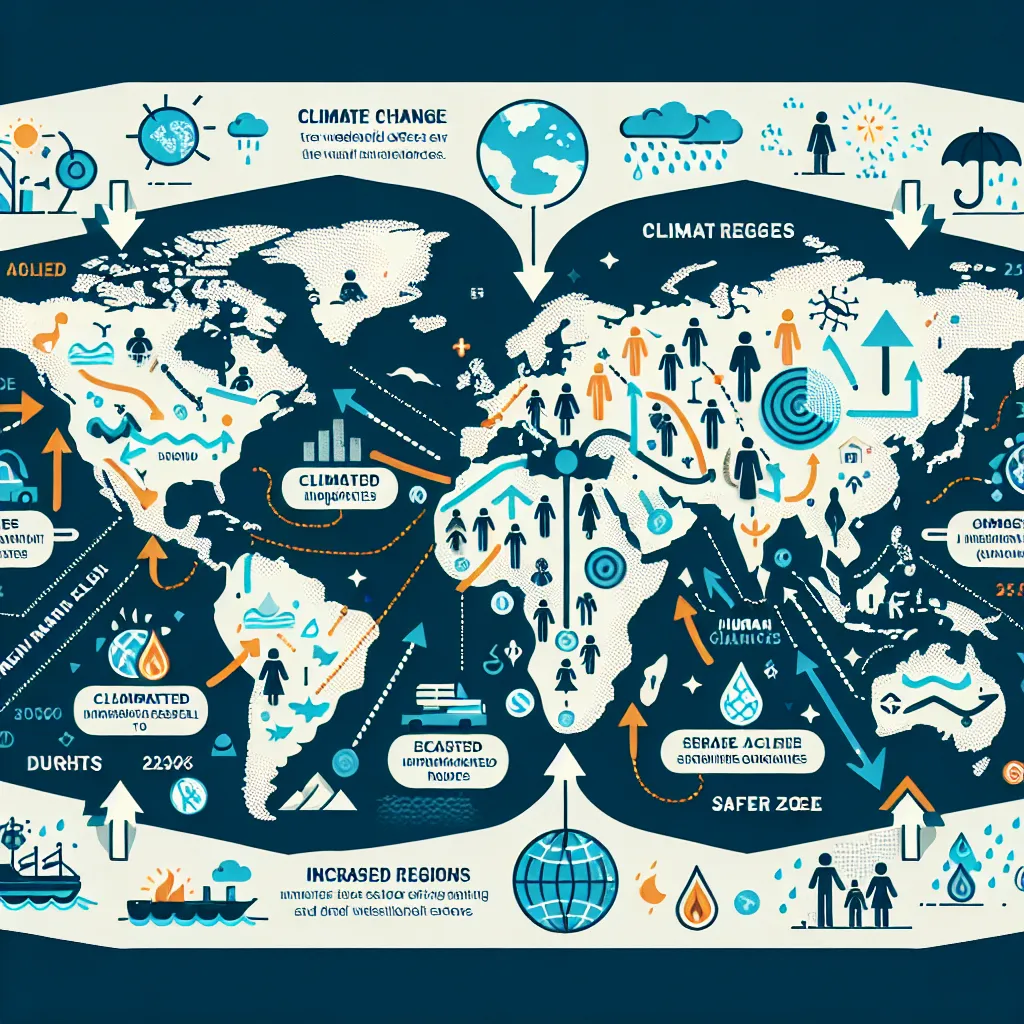The IELTS Reading section is a crucial component of the test, requiring candidates to demonstrate their ability to comprehend complex texts and answer various question types. Today, we’ll focus on a topic that has been increasingly prevalent in recent years: “The impact of climate change on global migration.” This subject has appeared in several past IELTS exams and, given its growing relevance, is likely to feature in future tests as well.
As an experienced IELTS instructor, I’ve observed that environmental topics, particularly those related to climate change and its consequences, have become more frequent in the Reading section. This trend reflects the global concern over climate issues and their far-reaching impacts on society. Let’s dive into a practice passage and questions to help you prepare for this type of content in your IELTS Reading test.
 Climate change impact on global migration
Climate change impact on global migration
Practice Passage: The Global Shift – Climate Change and Human Migration
Climate change is rapidly emerging as one of the most significant challenges of the 21st century, with far-reaching implications for ecosystems, economies, and human societies worldwide. Among its many consequences, the impact on global migration patterns is particularly noteworthy. As environmental conditions deteriorate in various regions, millions of people are being forced to relocate, creating a new category of migrants often referred to as “climate refugees.”
The relationship between climate change and migration is complex and multifaceted. Rising sea levels threaten coastal communities and small island nations, potentially displacing millions. In Bangladesh alone, it’s estimated that by 2050, one in every seven people could be displaced by climate change. Simultaneously, increasing frequency and intensity of extreme weather events such as hurricanes, floods, and droughts are rendering vast areas uninhabitable or economically unviable.
Agricultural regions are particularly vulnerable to climate change impacts. Shifting rainfall patterns and prolonged droughts are compromising food security in many parts of the world, especially in sub-Saharan Africa and South Asia. As crop yields decline and livelihoods become unsustainable, rural populations are increasingly migrating to urban areas or across borders in search of better opportunities.
However, it’s important to note that climate migration is not always a last resort. In many cases, it serves as an adaptation strategy, allowing communities to diversify their income sources and reduce their vulnerability to environmental risks. This “adaptive migration” can take various forms, from seasonal movement of pastoral communities to long-term relocation of entire villages.
The international community is grappling with how to address this growing phenomenon. The United Nations High Commissioner for Refugees (UNHCR) has highlighted the need for a coordinated global response to climate-induced displacement. However, current international refugee laws do not explicitly recognize climate change as a basis for refugee status, creating a legal gray area for those displaced by environmental factors.
Several initiatives are underway to address this gap. The Platform on Disaster Displacement, launched in 2016, aims to improve protection for people displaced across borders in the context of disasters and climate change. Similarly, the Global Compact for Safe, Orderly and Regular Migration, adopted by the UN General Assembly in 2018, recognizes climate change as a driver of migration and calls for enhanced cooperation on this issue.
As the impacts of climate change intensify, it’s clear that migration patterns will continue to evolve. This presents both challenges and opportunities for receiving countries. While large-scale migration can strain resources and infrastructure, it can also bring new skills, perspectives, and cultural diversity. Effectively managing climate-induced migration will require innovative policies, international cooperation, and a fundamental rethinking of our approach to human mobility in the face of environmental change.
Questions
True/False/Not Given
- Climate change is causing millions of people to relocate, creating a new category of migrants called “climate refugees.”
- By 2050, one in every five people in Bangladesh could be displaced due to climate change.
- Climate migration always occurs as a last resort when all other options have been exhausted.
- The UNHCR has called for a coordinated global response to climate-induced displacement.
- Current international refugee laws explicitly recognize climate change as a basis for refugee status.
Multiple Choice
-
Which of the following is NOT mentioned as a consequence of climate change affecting migration?
A) Rising sea levels
B) Extreme weather events
C) Volcanic eruptions
D) Shifting rainfall patterns -
According to the passage, adaptive migration can include:
A) Seasonal movement of pastoral communities
B) Long-term relocation of entire villages
C) Both A and B
D) Neither A nor B
Matching Information
Match the following statements (8-10) with the correct information from the passage (A-D).
- An initiative aimed at improving protection for people displaced across borders due to disasters and climate change.
- A document that recognizes climate change as a driver of migration and calls for enhanced cooperation.
- A region particularly vulnerable to climate change impacts on agriculture.
A) Platform on Disaster Displacement
B) Global Compact for Safe, Orderly and Regular Migration
C) Sub-Saharan Africa
D) United Nations High Commissioner for Refugees (UNHCR)
Short Answer Questions
- What term is used to describe migration as a strategy to reduce vulnerability to environmental risks? (Maximum 2 words)
- Name one positive impact that climate-induced migration can have on receiving countries. (Maximum 3 words)
Answer Key and Explanations
-
True – The passage states, “As environmental conditions deteriorate in various regions, millions of people are being forced to relocate, creating a new category of migrants often referred to as ‘climate refugees.'”
-
False – The passage mentions “one in every seven people,” not “one in every five.”
-
False – The passage states, “However, it’s important to note that climate migration is not always a last resort. In many cases, it serves as an adaptation strategy.”
-
True – The passage notes, “The United Nations High Commissioner for Refugees (UNHCR) has highlighted the need for a coordinated global response to climate-induced displacement.”
-
False – The passage clearly states, “However, current international refugee laws do not explicitly recognize climate change as a basis for refugee status.”
-
C) Volcanic eruptions – This is not mentioned in the passage as a consequence of climate change affecting migration.
-
C) Both A and B – The passage states, “This ‘adaptive migration’ can take various forms, from seasonal movement of pastoral communities to long-term relocation of entire villages.”
-
A) Platform on Disaster Displacement
-
B) Global Compact for Safe, Orderly and Regular Migration
-
C) Sub-Saharan Africa
-
Adaptive migration
-
Any of the following: new skills / perspectives / cultural diversity
Common Mistakes to Avoid
- Overlooking negative statements: In True/False/Not Given questions, be cautious of words like “not,” “never,” or “always.”
- Making assumptions: Stick to the information provided in the passage. Don’t bring in outside knowledge or make inferences beyond what’s stated.
- Misinterpreting numbers: Pay close attention to specific figures and statistics mentioned in the text.
- Falling for distractors: In multiple-choice questions, all options may seem plausible. Carefully eliminate those not supported by the passage.
- Exceeding word limits: In short answer questions, adhere strictly to the specified word limit.
Key Vocabulary
- Implications (noun) – /ˌɪm.plɪˈkeɪ.ʃən/ – the possible effect or result of an action or decision
- Multifaceted (adjective) – /ˌmʌl.tiˈfæs.ɪ.tɪd/ – having many different aspects or features
- Uninhabitable (adjective) – /ˌʌn.ɪnˈhæb.ɪ.tə.bəl/ – not suitable for people to live in
- Vulnerability (noun) – /ˌvʌl.nər.əˈbɪl.ə.ti/ – the quality of being easily hurt or attacked
- Grappling (verb) – /ˈɡræp.əl.ɪŋ/ – trying to deal with or understand a difficult problem or situation
Grammar Focus
Pay attention to the use of conditional sentences in the passage, particularly the zero and first conditionals:
-
Zero conditional: “As crop yields decline and livelihoods become unsustainable, rural populations are increasingly migrating…”
(Structure: If/When + present simple, present simple) -
First conditional: “Effectively managing climate-induced migration will require innovative policies…”
(Structure: If/When + present simple, will + infinitive)
These structures are commonly used to discuss cause-effect relationships and future possibilities, which are crucial in academic and scientific texts.
Tips for Success
- Time management: Allocate your time wisely. Spend about 20 minutes on each passage in the IELTS Reading test.
- Skim and scan: Quickly skim the passage for main ideas, then scan for specific details when answering questions.
- Use context clues: If you encounter unfamiliar words, try to deduce their meaning from the surrounding context.
- Practice regularly: Familiarize yourself with various question types and develop strategies for each.
- Stay informed: Read widely on current global issues, as topics like climate change are increasingly common in IELTS tests.
Remember, success in IELTS Reading comes from a combination of language skills, test-taking strategies, and broad general knowledge. Keep practicing with diverse texts and question types to improve your performance.
For more IELTS Reading practice materials, check out our articles on how climate change impacts global migration patterns and the effects of climate change on sea levels. These resources will help you further understand the complexities of environmental topics in IELTS Reading tests.


